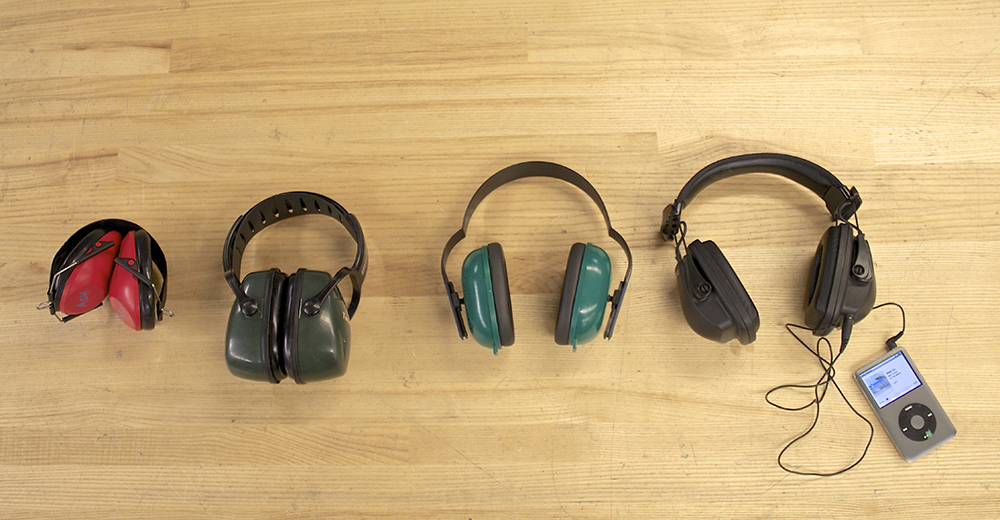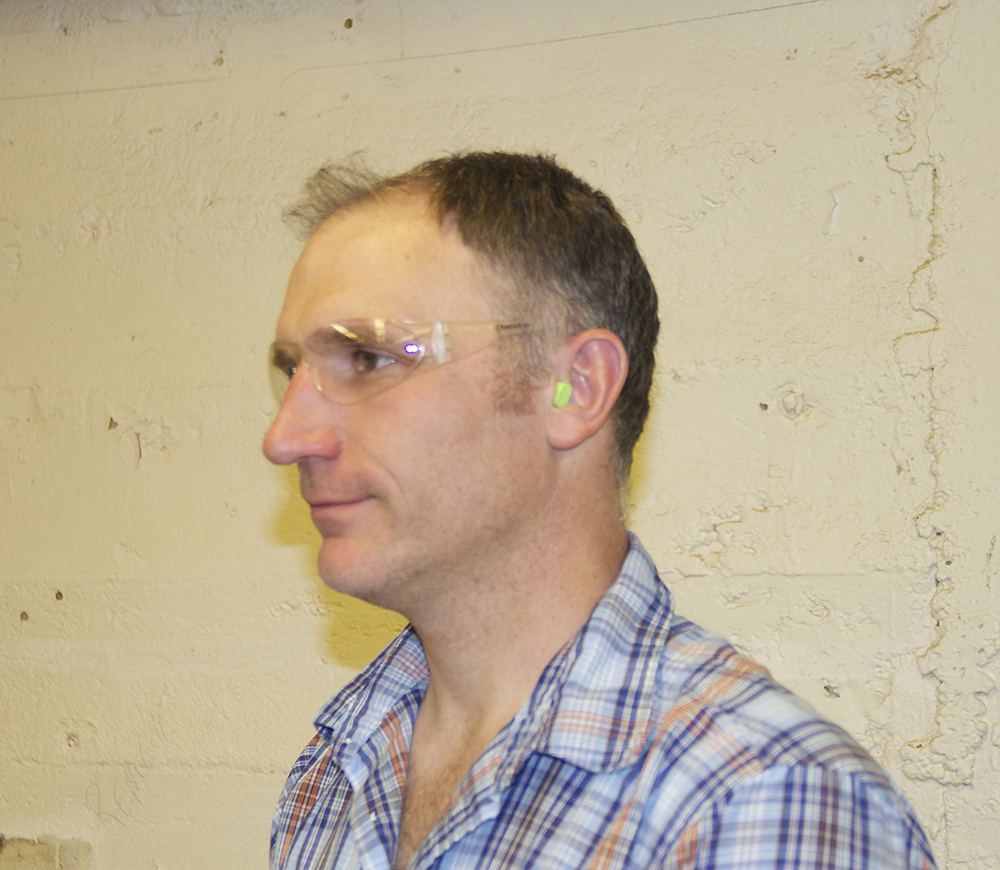Why Hearing Protection is Important
My first job out of college was framing houses. The contractor I worked for was ‘old school.’ Protective gear like gloves, earplugs or safety glasses were generally viewed as signs of weakness. For a long time I tried to be a tough guy. After an afternoon of air-nailing fire blocking between ceiling joists, my ears had had enough. I stopped by the hardware store on the way home from work and picked up a couple sets of foam ear-plugs and have never looked back. Audiologist Dr. Ryan Hamilton lauds my decision to protect my hearing, “Hearing loss occurs much sooner than one experiences pain from loud noises, so it is possible to have a degradation of hearing yet never experience discomfort!” And certain activities, which have short bursts of noise, like woodworking and shooting guns, (as opposed to working a jet runway for example which has constant noise) are particularly dangerous for hearing longevity.
How Loud are Your Tools?
 This OSHA diagram shows weighted sound levels measured in decibels. While the threshold for pain is around 140 dB, depending on the duration and level of the noise, hearing loss can occur above 90 dB in a matter of hours. To give some perspective for woodworkers, a bench top planer is often in the 105-110 dB range, and handheld routers are anywhere from 95-115 dB! Add in a powerful dust collector and that amounts to some serious noise! OSHA recommends hearing protection for any noise over 85 dB, and all of the hearing protection I profile reduces the impact on your ears by at least 25 dB. See below for the breadth of ear protection options.
This OSHA diagram shows weighted sound levels measured in decibels. While the threshold for pain is around 140 dB, depending on the duration and level of the noise, hearing loss can occur above 90 dB in a matter of hours. To give some perspective for woodworkers, a bench top planer is often in the 105-110 dB range, and handheld routers are anywhere from 95-115 dB! Add in a powerful dust collector and that amounts to some serious noise! OSHA recommends hearing protection for any noise over 85 dB, and all of the hearing protection I profile reduces the impact on your ears by at least 25 dB. See below for the breadth of ear protection options.
In-Ear Options
 Generally inexpensive, lightweight and having a low profile, ear-plugs fit well with other protective fixtures like goggles, respirators and face shields and range in price from .25 cents to $10.00. The most common is the ubiquitous disposable foam earplug, most often sold in large quantities. To install into the ear, compress the foam by rolling the plug to between your fingers and insert. In quantity, these are less than a quarter per pair, but reduce sound levels 27 dB, offering quite a bang for your buck. Foam earplugs are also available on a headband (pictured) or on a cord. Another in-ear plug consists of soft rubber concentric fins which, when inserted, conform to the ear canal and protect from loud noise. Ear plugs, however, are easy to lose and, naturally, get sticky ear-wax on them. If dropped in a woodshop, they get dusty and must be cleaned before inserting back into the ear, or tossed out and replaced. Cords, bands, storage pill-boxes or envelopes all help mitigate against the loss of these small hearing protectors.
Generally inexpensive, lightweight and having a low profile, ear-plugs fit well with other protective fixtures like goggles, respirators and face shields and range in price from .25 cents to $10.00. The most common is the ubiquitous disposable foam earplug, most often sold in large quantities. To install into the ear, compress the foam by rolling the plug to between your fingers and insert. In quantity, these are less than a quarter per pair, but reduce sound levels 27 dB, offering quite a bang for your buck. Foam earplugs are also available on a headband (pictured) or on a cord. Another in-ear plug consists of soft rubber concentric fins which, when inserted, conform to the ear canal and protect from loud noise. Ear plugs, however, are easy to lose and, naturally, get sticky ear-wax on them. If dropped in a woodshop, they get dusty and must be cleaned before inserting back into the ear, or tossed out and replaced. Cords, bands, storage pill-boxes or envelopes all help mitigate against the loss of these small hearing protectors.
Over-Ear Muffs
 Each style or brand of muff should be considered in conjunction with eye protection and/or respirators. Over the years, I have accumulated a number of styles, and each suits certain needs. From left to right, the first are a foldable version, which I really like to have when I go onsite for an install. Maybe I’ve gone soft, but even when performing relatively quiet tasks like running a jigsaw or vacuuming dust, I throw these on to protect my ears. Next is a nice set of muffs with soft ear padding and an adjustable padded headband. Yet another is an inexpensive set of muffs that accommodate eye protection (via the “Cs” in the head band). These are less adjustable and have a firm fit which may be best for a smaller head. Lastly is a pair of comfortable muffs with a headphone jack for pairing with an iPhone or other MP3 player. These come with a short removable audio cable; a perfect length without excess to dangerously catch on shop handles or stacks of wood. Other sets of headphones have Bluetooth or wireless options.
Each style or brand of muff should be considered in conjunction with eye protection and/or respirators. Over the years, I have accumulated a number of styles, and each suits certain needs. From left to right, the first are a foldable version, which I really like to have when I go onsite for an install. Maybe I’ve gone soft, but even when performing relatively quiet tasks like running a jigsaw or vacuuming dust, I throw these on to protect my ears. Next is a nice set of muffs with soft ear padding and an adjustable padded headband. Yet another is an inexpensive set of muffs that accommodate eye protection (via the “Cs” in the head band). These are less adjustable and have a firm fit which may be best for a smaller head. Lastly is a pair of comfortable muffs with a headphone jack for pairing with an iPhone or other MP3 player. These come with a short removable audio cable; a perfect length without excess to dangerously catch on shop handles or stacks of wood. Other sets of headphones have Bluetooth or wireless options.My recommendations? If I could only have one form of hearing protection I would choose the ‘SYNC’ muffs from Howard Leight. For my head and ears, they are the most comfortable, offer 25 dB reduction in volume, and have excellent sound quality from an MP3 player. I even take them when I travel. They’re perfect for taking on a plane and listening to my tunes! I also keep a bin of disposable plugs for guests, or when muffs go missing. Dr. Hamilton leaves me with these words of wisdom: “It doesn’t take long to experience hearing loss, and there is no way to regain it once gone.”
Howard Leight
‘SYNC’ Stereo Earmuff
(800) 430-5490
$40
Corded foam ear plugs
Howard Leight LL-30
$23/100 pr
Amazon.com

Great and excellent advice it's very useful for me. Thanks for sharing these!
I would love to know why I can see the videos without a problem but, none of the pictures in the articles come through. They appear as a little box with a X in it and the name of the picture. When I click on it, I get a message the states "The requested image can not be loaded, try again latter". What is going on? Jerry
Hearing protection is an absolute must. But something almost always not mentioned is that breaking the seal on muffs reduces their effectiveness. Those glasses we wear wear to protect our eyes (or just to be able to see) break that seal where the arms pass under the muff. This will gived at least a 5db reduction in the fasting of the muff.
growing up farming we never wore hearing protection & I regret it. I started wearing it later & keep some in my pockets at all times. whether it's a mower, loud vac, circular saw, etc--preventing damage is so much easier than saying "huh?" "huh?" "huh?"
that’s good, thanks for sharing,.. I think this is great blog
"The contractor I worked for was ‘old school.’ Protective gear like gloves, earplugs or safety glasses were generally viewed as signs of weakness. " Explaining once again why OSHA exists. You can wear earplugs and muffs. It may be overkill sometimes, but it doubles your protection. And depending on your taste in music, an mp3 player may be more dangerous than that screaming router.
I use the ear muffs also I listen to music. I put ear buds for mp3 players and time just flies bye. I do this also when working outside mowing the lawn, etc.